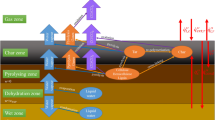Summary
Giant sequoia latewood compression wood (CW) tracheids had pit canals that flared toward the lumen with extended poorly defined inner apertures that paralleled the fibrils in the S2 walls. Boiling and drying of CW and normal wood (NW) blocks induced split extensions at the CW pit aperture grooves but not at the NW pit apertures. These split extensions of the CW pit apertures were present also in longitudinal microsections. The mean fibril angle of 21 to 25 degrees of this well-defined CW was appreciably below the 45 degrees frequently reported. The CW tangential/radial shrinkage ratio of about 1 was distinetly lower than NW (1.6 and 2.1), and appeared to be the result of much lower tangential shrinkage. Both NW and CW specimens when dried quickly in an oven at 100° C had higher shrinkage (long., tang. and rad.) than when air-dried first at lower temperature and higher relative humidity.
Similar content being viewed by others
References
Cockrell, R. A. 1946. Influence of fibril angle on longitudinal shrinkage of ponderosa pine wood. J. of Forestry 44 (11): 876–878.
Cockrell, R. A., Knudson, R. M., Stangenberger, A. G. 1971. Mechanical properties of southern sierra old- and second-growth giant sequoia. California Agric. Exp. Stat. Bulletin 854.
Cockrell, R. A. 1973. The effect of specimen preparation on compression wood and normal latewood pits and wall configurations of giant sequoia. Bulletin Internat. Assoc. of Wood Anatomists. 1973, No. 4.
Cockrell, R. A., Knudson, R.M. 1973. A comparison of static bending, compression and tension parallel to grain and toughness properties of compression wood and normal wood of a giant sequoia. Wood Sci. Technol. 7: 241–250.
Jane, F. W. 1970. The structure of wood. 2nd Edition. Black, London.
Espenas, L. D. 1971. Shrinkage of Douglas fir, western hemlock and red alder as affected by drying conditions. Forest Prod. J. 21 (6): 44–46.
Forest Products Laboratory. 1960. Longitudinal shrinkage of wood. U.S.D.A., Forest Service, FPL Mimeo Rep. No. 1093.
Harris, J. M., Meylan, B. A. 1965. The influence of microfibril angle on longitudinal and tangential shrinkage of Pinus radiata. Holzforschung 19 (5): 144–153.
Luxford, R. F., Markwardt, L. J. 1932. The strength and related properties of redwood. U.S. Dept. of Agr. Tech. Bul. 305.
Panshin, A. J., de Zeeuw, C. 1970. Textbook of wood technology, Vol. I, 3rd Edition. McGraw-Hill, N.Y.
Pillow, M.Y., Luxford, R. F. 1937. Structure, occurrence, and properties of compression wood. U.S. Dept. of Agr. Tech. Bul. 546.
Tsoumis, G. 1968. Wood as raw material. Pergamon Press, Oxford.
Wardrop, A. B. 1965. The formation and function of reaction wood. p. 371–390. In: W. A. Côté (Ed.), Cellular ultrastructure of woody plants, Syracuse University Press.
Author information
Authors and Affiliations
Additional information
The SEM photographs were made in the Electronics Research Laboratory which is under the direction of Dr. T. E. Everhart who has a Cambridge Stereoscan Mark II SEM operated under NIH Grant No. G. M. 17523.
Rights and permissions
About this article
Cite this article
Cockrell, R.A. A comparison of latewood pits, fibril orientation, and shrinkage of normal and compression wood of giant sequoia. Wood Science and Technology 8, 197–206 (1974). https://doi.org/10.1007/BF00352023
Received:
Issue Date:
DOI: https://doi.org/10.1007/BF00352023




